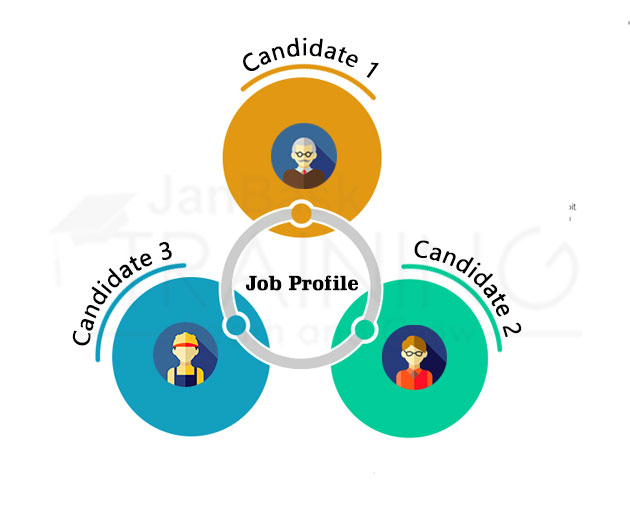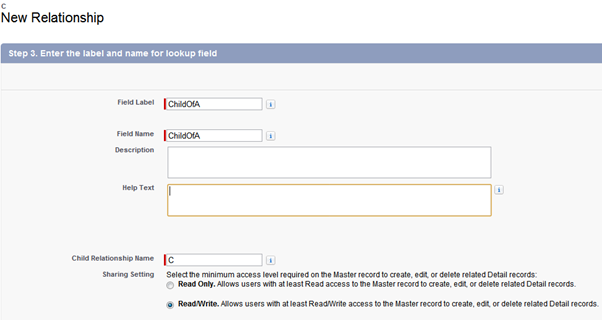23
JulInternational Womens Day : Flat 30% off on live classes + 2 free self-paced courses - SCHEDULE CALL
A Junction is an object which is used to combine two master-detail relationships. In a layman’s language, when two relationships came together injunction, they form one relationship out of the two.
Case 1: One to Many Relationships
Case 2: Many to One Relationship
Result: Many to Many Relationships
We have taken an easy example of a recruitment application that will clarify the meaning and usage of the Junction object. However, to ensure a successful career as a Salesforce professional, join a professional and industry-recognized Online Salesforce Training course.
Case 1: There can be only one Position available for a particular job profile. But for that particular job profile, there can be multiple candidates. This is the case of One to Many relationships. That is one job and many candidates. 
Case 2: There can be only one candidate who is eligible for many job profiles. This is the case of the Many to One relationship. That is one candidate and many job profiles. Result: To make both of the two cases compatible with each other, we need to create another 3rd case (Salesforce Lookup field) for both the cases that is, job position and candidate. As a result, it will return a kind of filter option using which compatibility of both cases will be found. We will be able to look either for the applicant who is compatible with different job profiles, or the job profile for which multiple candidates are eligible. This is the case of Many to Many relationships.
Result: To make both of the two cases compatible with each other, we need to create another 3rd case (Salesforce Lookup field) for both the cases that is, job position and candidate. As a result, it will return a kind of filter option using which compatibility of both cases will be found. We will be able to look either for the applicant who is compatible with different job profiles, or the job profile for which multiple candidates are eligible. This is the case of Many to Many relationships.
Are you all set to learn Salesforce and grow your Salesforce career? Here is a guide on How Long Does It Take To Learn Salesforce? Get a Real Estimate
In Salesforce, there are objects called “Junction.” The Junction objects are used in Salesforce to build relationships in multiple capabilities between the things in Salesforce. When there is a requirement to link several different things with one thing or one object, therefore, there can be many applicants for particular applications. Many examples are relatable to Salesforce Junction object. Like- Car dealership: many vehicles and many Customers, Pharmaceuticals: many medicines and many patients, many educational programs and many students, and much more. 
There are two fields to achieve Salesforce Junction object. They are both one to many relationships; and they are both defined from many to one side that is, from a child to a parent. They can be made one to one relationship by adjoining validation rules or may trigger to enforce one to one nature; that is, only one child is allowed. Detail of the two fields of Salesforce – Master-detail, and Lookup are given below: -
However, If you are just starting your career in Salesforce, consider going for a Salesforce Cloud Course to move your career on the right path.
In M: M relationship, one record o one object is linked to multiple records of another object and vice versa. In Salesforce, there is no pre-availability of Many to Many relationships, but we create them; which is done by creating two master-details relationships with a Junction Object which is common.
It is the most common question that is asked in the interview with Salesforce applicants. It is a custom object that is used to link one exemplar of a record to many child records and many child records to on record equally. Examples are already mentioned above. Now, we will learn step-by-step procedures to create a Junction object for Many to Many relationships in Salesforce. To create Many-to-many relationships, initially, we have to create a Junction object. 
Go through various Salesforce blogs and training courses available on the JanBask Training which may really increase your knowledge and answer your queries related to Salesforce.
Let us assume we want to relate A and B, and have to create one more object C. C will be the Junction object. Let us start with creating a Custom Junction Object. Initially, we will create an object A.  Now, we have to create two more objects B and C in the same way as object A is created. Now, we are going to use Object C as a junction object for A and B. Create “First Master-detail” field on the object and select object A as a parent. This will act as the Primary master-detailed relationship.
Now, we have to create two more objects B and C in the same way as object A is created. Now, we are going to use Object C as a junction object for A and B. Create “First Master-detail” field on the object and select object A as a parent. This will act as the Primary master-detailed relationship. 
In the next view, you have to assign a name to the field.  For the Master record A, we have assigned the name “ChildOfA” and in the same manner, for B we have assigned the name “ChildOfB”. So, until now, we have created two objects- Object A and Object B. Now we can create a tab for all the custom objects to add the new record. Firstly, create the record A and B and for record C, follow the screenshot below:-
For the Master record A, we have assigned the name “ChildOfA” and in the same manner, for B we have assigned the name “ChildOfB”. So, until now, we have created two objects- Object A and Object B. Now we can create a tab for all the custom objects to add the new record. Firstly, create the record A and B and for record C, follow the screenshot below:- 
Tip: Take this 2-minute Salesforce Quiz to check your Salesforce knowledge and stay updated with the latest updates and innovations in Salesforce.
Also, if you are seriously looking to start your career in Salesforce. Check out What is Salesforce Sandbox? & How to Create & Uses of Sandbox?
The next step is to add fields on the Positions Page layout.
Now, add fields to the position related list on the site page layout
Consider joining the JanBask Salesforce community which may keep you updated with the new trends of Salesforce and the latest c.
Now, testing for all what you have done
Object helps in the creation of Many to Many relationships which may consist of:-
 The order of master objects in the report type is important. Other than that, the master object which listed object first determines the scope of records that are displayed in the report. Based on this, you can create custom reports based on these standard based reports. You can also create custom type report to customize which is related to the objects that are joined in the report. Summing up, Salesforce is not just a game player but the game-changing CRM platform. So ride the wave of Salesforce and explore wider features. If you want to know more about Salesforce, you should take Online Salesforce training and play around with records that are made specifically for that purpose only.
The order of master objects in the report type is important. Other than that, the master object which listed object first determines the scope of records that are displayed in the report. Based on this, you can create custom reports based on these standard based reports. You can also create custom type report to customize which is related to the objects that are joined in the report. Summing up, Salesforce is not just a game player but the game-changing CRM platform. So ride the wave of Salesforce and explore wider features. If you want to know more about Salesforce, you should take Online Salesforce training and play around with records that are made specifically for that purpose only.
Q1. What do I need to do to earn the Salesforce certification?
Ans- Join JanBask Training’s Salesforce Certification Training Program to master the concepts of Salesforce Admin and Developer while focusing on Sales & Service Cloud, Apex Programming, Salesforce Lightning, and much more.
Q2. What are the career benefits of this Salesforce Certification Training Program?
Ans- According to Glassdoor, Salesforce jobs are increasing at a speed 1.5 times faster than similar roles, and there were 300,000+ Salesforce jobs available. Salesforce Certified Administrators earn an annual average salary of $87,000 but can go as high as $160,000 depending on their knowledge, skills, and experience.
Q3. How do I pass the Salesforce Exam?
Ans- It’s a 90-minute long exam comprising 60 single or multiple choice questions. The passing score for the exam is 65% i.e you should answer 39 questions correctly.
Q4. Do you provide a practice test as a part of this Salesforce Certification Training Program?
Ans- Yes, we do provide a practice test as part of our course to help you prepare for the actual certification exam. You can try this free Salesforce Quiz to understand the type of tests that are part of the course curriculum.
Q5. Why are Salesforce certifications necessary?
Ans- Salesforce Certifications are necessary as they:
Q6. How do you help with job placements?
Ans- To help you perform better in the job’s hiring processes:
Q7. Which Salesforce Admin certifications are in demand?
Ans- Salesforce currently offers following stages of administrator certifications:
Q8. What skills will I learn from this course?
Ans- From this course, you will be able to master the Salesforce clouds like Salesforce administration and development skills along with sales cloud, service cloud, community cloud, analytics cloud, marketing cloud, etc., report generation, dashboards, and the basics of integration. SFDC data model, different building blocks of Salesforce, a deep understanding of the Salesforce security model, Salesforce lightning components, salesforce apex triggers, salesforce test classes, and the Salesforce automation options.
Q9. What can I expect after the course?
Ans- After the completion of this course, you will have a crisp & strong preparation base to pursue the Salesforce certification exams and thorough knowledge, methods & confidence on how to proceed in the right Salesforce job market. A Salesforce Training Certification for completing the online Salesforce training with JanBask Training (Salesforce Accredited Training Organization). Our Training completion certification is highly accepted & known in the small scale to big scale and local to global job markets. It gives a great push in the job hiring process.
Q10. Can a non-I.T person do a Salesforce course?
Ans- We start the training from the basic level so that anyone can start even if he belongs to a non-IT background. So, it is not necessary to be from an IT background to join this course but a right zeal to learn Salesforce basics is enough to start a career with us right away.Our salesforce Beginner to Advanced courses sessions will start from the very basics, Salesforce history, how it was started and why it is necessary to learn, etc.
 Pinterest
Pinterest
 Email
Email
The JanBask Training Team includes certified professionals and expert writers dedicated to helping learners navigate their career journeys in QA, Cybersecurity, Salesforce, and more. Each article is carefully researched and reviewed to ensure quality and relevance.

Cyber Security

QA

Salesforce

Business Analyst

MS SQL Server

Data Science

DevOps

Hadoop

Python

Artificial Intelligence

Machine Learning

Tableau
Search Posts
Related Posts
Difference Between Salesforce Classic and Lightning Experience
![]() 790k
790k
App Builder Salesforce Certification - Complete Exam Details & Passing Tips
![]() 230k
230k
Advance Your Career by Imbibing the Skills with Salesforce Certification
![]() 5k
5k
Top 7 Impactful Data Loaders Tools for Salesforce : Import & Export Data
![]() 262.4k
262.4k
Receive Latest Materials and Offers on Salesforce Course
Interviews